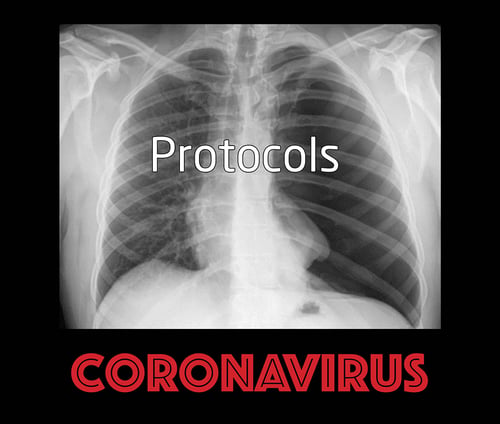A group of Italian experts has published the first protocol for the use of lung ultrasound to quantitively and reproducibly assess  the degree of lung involvement in patients suspected of having COVID-19 infection.
the degree of lung involvement in patients suspected of having COVID-19 infection.
Libertario Demi, PhD, head of the ultrasound laboratory, University of Trento, Italy, and colleagues have developed a protocol to standardize practice, which was published online on March 30 in the Journal of Ultrasound Medicine, to standardize practice. Their research offers broad agreement with industry-led algorithms and emphasizes the use of wireless, handheld ultrasound devices, ideally consisting of a separate probe and tablet, to make sterilization easy. Butterfly Network, Phillips, Clarius, GE Healthcare and Siemens are among numerous companies that produce one or more such devices, including some that are completely integrated.
While lung ultrasound is not universally accepted for diagnosing pneumonia in the context of COVID-19 and triaging patients, Giovanni Volpicelli, MD, University Hospital San Luigi Gonzaga, Turin, Italy says many COVID-19 patients that presented with a negative chest x-ray were found to have interstitial pneumonia on lung ultrasound. And when patients don’t have to be transported to the radiology department but can remain in the emergency room and undergo lung ultrasound there, the risk of nosocomial infection is more easily controlled.
The goal of publishing the protocol was “to share our experience and to propose a standardization with respect to the use of lung ultrasound in the management of COVID-19 patients.”
Approximately 60,000 ultrasound images of confirmed COVID-19 cases were reviewed without access to the patients’ clinical backgrounds.
The authors recommend scanning 14 areas in each patient for 10 seconds, making the scans intercoastal to cover the widest possible surface area. They also advise the use of a single focal point on the pleural line which optimizes the beam shape for observing the lung surface. Cosmetic filters and modalities like harmonic imaging, doppler, contrast and compounding should be avoided and the mechanical index should be kept low.
Volpicelli said, “There are situations where lung ultrasound can be considered definitive. For instance, if I see a patient with mild signs of the disease, just fever, and I perform lung ultrasound and see nothing,
lung ultrasound rules out pneumonia." He said, "This patient may have COVID-19 of course, but they do not have pneumonia, and they can be treated at home, awaiting the result of the swab test. And this is useful because you can reduce the burden in the emergency department."
He continued, "On the other hand, there are patients with acute respiratory failure in respiratory distress. If the lung ultrasound is normal, you can rule out COVID-19 and you need to use other diagnostic procedures to understand the problem. This is also very important for us because it's crucial to be able to remove the patient from the isolation area and perform CT scan, chest radiography, and all the other diagnostic tools that we need."
The Italian team said, “in the setting of COVID-19, wireless probes and tablets represent the most appropriate ultrasound equipment," as they can "easily be wrapped in single-use plastic covers, reducing the risk of contamination," and making sterilization easy.
Volpicelli doesn't like what he sees as undue focus on wireless devices for lung ultrasound in the COVID-19 protocols. For him, the issue of cross-contamination with standard lung ultrasound machines is "nonexistent. Cleaning the machine is quite easy and I do it hundreds of times per week." However, if the lung ultrasound is performed when a patient is using a continuous positive airway pressure (CPAP) machine, the risk of contamination is much higher and a more intensive cleaning procedure is warranted.
"Not all centers have wireless machines, whereas a normal machine is usually in all hospitals,” he said. “The advantages of using lung ultrasound [in COVID-19] are too great to be limited by something that is not important in my opinion.”
The team at Atlantis Worldwide continues to monitor the role of medical imaging devices during the COVID-19 crisis. If you are in the market for medical imaging equipment for your practice, hospital, clinic or urgent care facility, remember that refurbished or used equipment can often deliver the performance you want, the warranty you need and a price that helps your bottom line.
Some blogs you may have missed:
- 4 Tips on X-Ray Tubes
- CR to DR: Digital Radiographic Upgrades And Options
- The 101 On Veterinary X-Ray Equipment
- MRI Infographic: Closed Bore, Open MRI & Wide Bore
- Six Key Considerations for Radiology Equipment Selection
- Free Medical Imaging Resources
About the author: Vikki Harmonay




